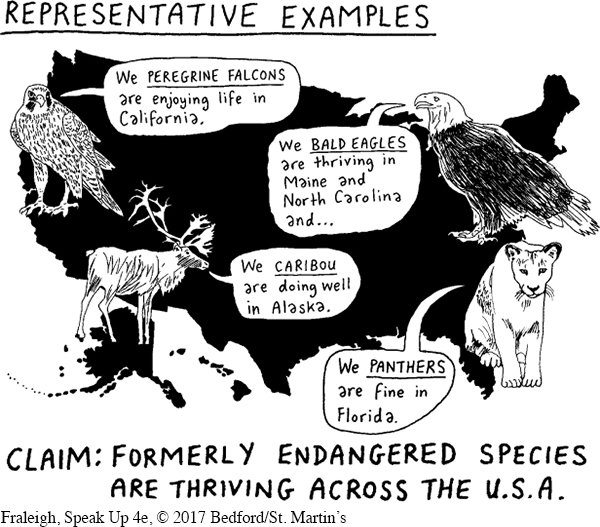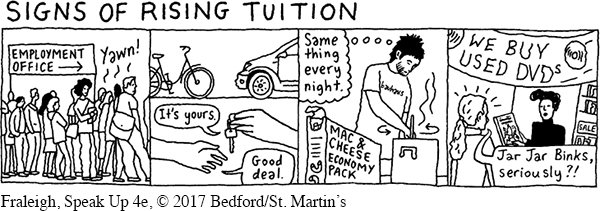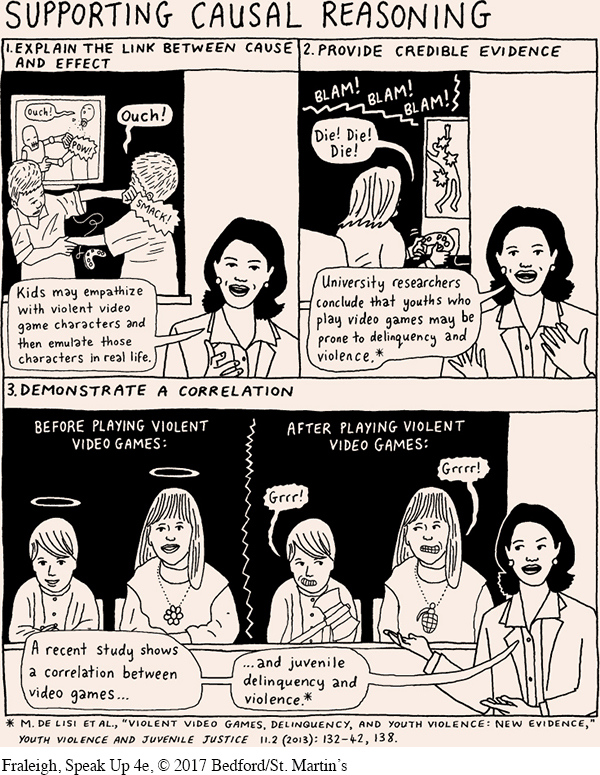Using Reasoning
Reasoning is the line of thought that connects the facts you present and the conclusions you draw from those facts. Persuasive speakers typically use inductive reasoning—generalizing from facts, instances, or examples and then making a claim based on that generalization. The table on page 547 shows several examples of inductive reasoning from everyday life.

547
| Fact | Claim |
|---|---|
| At three different locations at this university, food service was slow. | All food- |
| Lonyae is good at football. | It’s plausible that Lonyae would be good at soccer. |
| Two students in the back row just fell asleep. | This is a boring class. |
| Sarah does not save enough time to study or write papers. | Sarah is likely to receive a low grade. |
There are four types of inductive reasoning—
Example Reasoning. When you use example reasoning, you present specific instances to support a general claim. Your goal is to persuade the audience that your examples supply sufficient proof of your claim.
For instance, here’s how you could use example reasoning to argue that endangered species are making a comeback:
The Fortymile caribou herd reached a low of 5,000 members in Alaska and the Yukon in 1976. Now, the herd exceeds 46,000 and is growing in range.11 In California, the peregrine falcon has been taken off the endangered species list, and Yosemite National Park has been a key site for recovery.12 And there are now more than 9,700 breeding pairs of bald eagles in the lower 48 states, far more than the 487 pairs in 1963.13

548

549
To use example reasoning skillfully, be sure to provide enough instances to persuade your audience that your general claim is reasonable. The more examples you can find, the more confident you can be that your claim is correct.
Of course, in a short speech, you may have time to present only three or four examples to back up your argument. In this situation, you’ll need to choose the most representative examples. A representative example is an instance typical of the class it represents. For example, if you wanted to present an even more compelling case that endangered species are making a comeback, you might want to provide examples of species that live in a variety of regions in North America.

If you’re planning to use example reasoning in a speech you’re researching, think about counterexamples your audience may consider. For instance, some listeners may argue that whereas certain species are recovering their populations, others are still endangered. Thus, they may view your claim that “endangered species are making a comeback” as inaccurate. If such counterexamples have merit, you may need to revise your claim to “some endangered species are making a comeback.”

550
Comparison Reasoning. When you use comparison reasoning, you argue that two instances are similar and that what you know is true for one instance is likely to be true for the other. For example, if you argue that the prohibition of marijuana can’t succeed because prohibition of alcohol failed, you would be using this type of reasoning.
For comparison reasoning to work, your audience must agree (or be persuaded) that the two instances are in fact comparable. To illustrate, suppose you can show that marijuana use is similar to alcohol use and that current marijuana laws resemble earlier alcohol-
To further strengthen your comparison reasoning, make sure your audience accepts the “known facts” as true. For example, perhaps your listeners would argue that alcohol prohibition in the United States wasn’t actually a failure if it reduced alcohol consumption significantly. In this case, you might have to note other ways in which such prohibition could be considered a failure. For example, it led to the rise of organized crime when entities such as the Mafia took over bootlegging operations to counter government raids on speakeasies.

Sign Reasoning. When you use sign reasoning, you claim that a fact is true because indirect indicators (signs) are consistent with that fact. For example, you might claim that college students are facing serious financial challenges, as evidenced by students working longer hours.
551

This type of reasoning is most effective if you can cite multiple consistent signs of the fact you are claiming. For instance, you could strengthen your claim that students’ financial challenges are rising by also noting an increase in student loans and a higher rate of students dropping out of school. However, as you’re researching your speech, be sure to look for signs that are inconsistent with your argument. If you discover that students are spending more money on entertainment and clothes, you may find it difficult to convince your audience that the signs prove that financial struggles are on the rise.
You might use sign reasoning to decide whether you should take a particular class. For example, you might note that on the first day of the semester, the classroom is so full that students are sitting on the floor. Furthermore, there is a long waiting list for the class, and the book for the course is sold out at the bookstore. Each of these facts would be an indirect indicator that the course and the instructor are very good.
Causal Reasoning. When you use causal reasoning, you argue that one event has caused another. For instance, you would be using causal reasoning if you claimed that playing violent video games leads children to get involved in destructive and illegal activities.
You can strengthen your causal reasoning in several ways. One way is to explain the link between cause and effect. For example, you might contend that when children play violent games, some may empathize with the violent character they control in the games. Thus, they are more likely to emulate that character in their everyday lives. Another way to use causal reasoning effectively is to support the cause-
552

553
Causal reasoning can be tricky because it is easy to misinterpret the evidence or come to the wrong conclusion. We take a look at errors in causal reasoning and other common reasoning errors in the following section.
To see an example of a speaker using inductive reasoning, try Video Activity 18.1, “Reasoning: Inductive.”